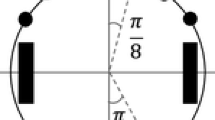Abstract
Verbal communication between individuals requires the parallel evolution of a vocal system capable of emitting different sounds and of an auditory system able to recognize each vocal pattern. In this work we present the evolution of a population of twins where the selection pressure is based on the ability of learning a communication pattern which allows verbal transmission of information. The fitness of each pair of twins (i.e. individuals having the same genotype) is based on the percentage of correct recognition of the perceived sounds. Results indicate the evolved communication system, in absence of noise, rapidly evolves and reaches almost 100% correct classifications, while, even in presence of a strong noise either in the channel, or in the sound generation parameters, the system can obtain a very good performance (approximately 80% correct classifications in the worst case).
Access this chapter
Tax calculation will be finalised at checkout
Purchases are for personal use only
Preview
Unable to display preview. Download preview PDF.
Similar content being viewed by others
References
Beautemps, D., Badin, P., Laboissière, R.: Deriving vocal-tract area functions from midsagittal profiles and formant frequencies: A new model for vowels and fricative consonants based on experimental data. Speech Communication 16(1), 27–47 (1995)
Bonada, J., Loscos, A., Cano, P., Serra, X., Kenmochi, H.: Spectral approach to the modeling of the singing voice. In: Proceedings of 111th AES Convention (2001)
Christophe, B.D., Henrich, N.: The voice source as a causal/anticausal linear filter. In: Proc. ISCA ITRW VOQUAL 2003, pp. 15–19 (2003)
Clément, P., Hans, S., Hartl, D., Maeda, S., Vaissière, J., Brasnu, D.: Vocal tract area function for vowels using three-dimensional magnetic resonance imaging. a preliminary study. Journal of Voice 21, 522–530 (2007)
Deller, J.J.R., Hansen, J.H.L., Proakis, J.G.: Discrete-Time Processing of Speech Signals, 2nd edn. Wiley-IEEE Press, Chichester (1999)
Kob, M., Alhäuser, N., Reiter, U.: Time-domain model of the singing voice (1999)
Macon, M.W., Clements, M.A.: Sinusoidal modeling and modification of unvoiced speech. IEEE Transactions on Speech and Audio Processing, 557–560 (1997)
Maeda, S.: A digital simulation method of the vocal-tract system. Speech Communication 1, 199–229 (1982)
Narayanan, S., Alwan, A.: Noise source models for fricative consonants. IEEE Transactions on Speech and Audio Processing 8, 2000 (2000)
Rabiner, L., Schafer, R.: Digital Processing of Speech Signals. Prentice Hall, Englewood Cliffs (1978)
Rabiner, L.R., Juang, B.H.: Fundamentals of Speech Recognition. Prentice Hall, Englewood Cliffs (1993)
Story, B., Titze, I.: Parameterization of vocal tract area functions by empirical orthogonal modes. J. Phonetics 26, 223–260 (1998)
Wakita, H.: Direct estimation of the vocal tract shape by inverse filtering of acoustic speech waveforms. IEEE Transactions on Audio and Electroacoustics 21(5), 417–427 (1973)
Author information
Authors and Affiliations
Editor information
Editors and Affiliations
Rights and permissions
Copyright information
© 2010 Springer-Verlag Berlin Heidelberg
About this paper
Cite this paper
Bocchi, L., Lapi, S., Ballerini, L. (2010). Evolution of Communicating Individuals. In: Di Chio, C., et al. Applications of Evolutionary Computation. EvoApplications 2010. Lecture Notes in Computer Science, vol 6024. Springer, Berlin, Heidelberg. https://doi.org/10.1007/978-3-642-12239-2_34
Download citation
DOI: https://doi.org/10.1007/978-3-642-12239-2_34
Publisher Name: Springer, Berlin, Heidelberg
Print ISBN: 978-3-642-12238-5
Online ISBN: 978-3-642-12239-2
eBook Packages: Computer ScienceComputer Science (R0)





